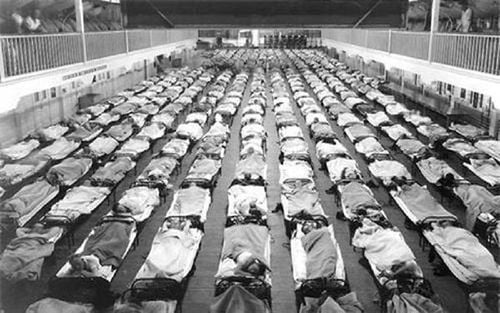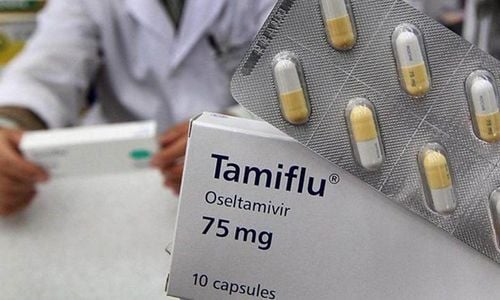This is an automatically translated article.
The article was professionally consulted by Doctor Pham Thi Khuong - Infectious Diseases Doctor, Pediatric Center, Vinmec Times City International General Hospital.Influenza A/H1N1 is very contagious and breaks out into an epidemic, but we often confuse it with the common flu. Untimely treatment can leave many dangerous complications, even death.
1. How to recognize influenza A/H1N1
Influenza virus has caused many major epidemics in the world with high mortality rates. There are 3 types of influenza viruses, A, B and C, in which influenza A virus often causes pandemics. Virus strains can change from year to year.Influenza A/H1N1 is transmitted from person to person, and quickly breaks out into an epidemic, with diverse clinical manifestations, many severe cases, rapid progression, and easy death.
Symptoms of human influenza A/H1N1 virus are similar to those of seasonal flu and include fever, cough, sore throat, runny or stuffy nose, body aches, headache, chills and fatigue, sometimes diarrhea.
Illnesses related to influenza A/H1N1 viruses range from mild to severe. Most people who become ill recover without drug treatment, but hospitalizations and deaths have also been reported. As with seasonal flu, those most at risk of serious complications from the flu are children under 5 years of age, pregnant women, and people of all ages with chronic medical conditions such as diabetes, high blood pressure, and diabetes. chronic obstructive pulmonary disease (COPD).
Typical symptoms of influenza A/H1N1 include
The patient will have a fever above 38 degrees Celsius, chills, sore throat, cough, stuffy nose, runny nose, headache, chills, body aches and muscle aches. - joint, fatigue. Some people also have symptoms of nausea, vomiting, abdominal pain, diarrhea. More severe will lead to shortness of breath, pneumonia. Symptoms of influenza A/H1N1 are easily confused with the common cold. To distinguish between influenza A/H1N1 or common flu, the best way is to do a nasopharyngeal swab test. Go to a reputable medical facility for examination as soon as you have the above suspected symptoms, especially during the A/H1N1 flu season.

Bệnh nhân cúm A/H1N1 thường có biểu hiện sốt cao, rét run, sổ mũi
2. How is influenza A/H1N1 transmitted?
Influenza A/H1N1 virus can be transmitted from person to person in the following ways:Spread by respiratory route: Through secretions, droplets when the patient coughs, sneezes, splashes into the environment...
Transmission by contact: When you accidentally touch the surfaces of everyday objects containing the virus, then touch your eyes, nose, and mouth, where bacteria can enter the body.
Influenza A/H1N1 is transmitted from person to person 1 day before the onset of illness and lasts 7 days after the onset of illness. Children have a longer infectious period. Sharing utensils, drinking glasses, or toothbrushes with an infected person can also spread the influenza A/H1N1 virus.
Features to identify influenza A/H1N1 epidemic include:
The incidence is usually high, contagious and can quickly cause a pandemic. The mortality rate is low (1 - 4%). Influenza A/H1N1 virus survives for a long time in the environment, 24-48 hours on frequently touched surfaces such as tables, chairs, stair handrails, doorknobs, cabinets... In clothing, it exists. from 8 to 12 hours. Can be kept in the palm of your hand for up to 5 minutes. The aquatic environment is a suitable environment for this virus to exist. In particular, the hotel pool environment, rainy weather, lack of sunshine... is the right environment for them to be more active.
Trắc nghiệm: Bạn có phân biệt được chính xác cảm lạnh và cúm mùa?
Cảm cúm và cảm lạnh là hai khái niệm mà chúng ta thường đánh đồng nó giống nhau, không phân biệt rõ ràng. Dưới đây là một số câu hỏi trắc nghiệm, giúp bạn có thêm những kiến thức phân biệt cảm lạnh và cảm cúm. Từ đó, có những biện pháp điều trị bệnh phù hợp.3. How to prevent influenza A/H1N1?
Influenza A/H1N1 is a very contagious disease with a rapid rate. Therefore, it is necessary to adhere to some basic preventive measures for yourself and your family as follows:Ensure personal hygiene, wash hands with antibacterial soap after going out, before returning home. eating and after going to the toilet. When sneezing or coughing, you should cover your mouth and nose with your elbow to avoid splashing around a lot. Wear a medical paper mask to protect yourself, avoid spreading the disease by droplets when going out and at risk places.

Đeo khẩu trang y tế để phòng cúm
4. What to do when suspected influenza A/H1N1?
Testing: It is necessary to do tests to determine whether influenza A/H1N1 is present, especially during an epidemic.See your doctor if you have any of the following signs and suspect you have influenza A/H1N1.
For children: Children breathe fast, feeling short of breath. Blue skin, pale mucous membranes. Unable to drink water, vomiting repeatedly, or vomiting continuously. Children doze off, tired and refuse to play. The fever can be gone for 1-2 days, the runny nose will be relieved, but then the fever will be more, and the cough will be more severe. For adults: Shortness of breath, rapid breathing. Feeling of pain, pressure in the chest, abdomen. Or get shocked. Do not awake. Vomiting, vomiting increased many times, continuously. The condition gradually worsened, the cough and fever got worse. Isolation when sick: Stay home for at least 24 hours after the fever is gone (do not use fever reducers). Avoid crowds, avoid schools, and isolate yourself from family and friends to avoid spreading the flu virus to others.
Take medicine as prescribed: Stock up on medicine according to the doctor's prescription, use the correct dose that the doctor has prescribed.
Sanitize living space: For the patient's utensils, clothes, and linen, need to be washed and sterilized. Separate the patient's belongings to prevent spread.
Influenza A/H1N1 is a dangerous disease that can threaten the life of you and your family. However, it is possible to prevent the disease by taking proactive measures such as keeping the body healthy, avoiding colds, and getting the flu vaccine fully and on time. Or when you suspect a loved one or yourself is sick, wear a medical mask and go to medical facilities to be tested and diagnosed in a timely manner.
Please dial HOTLINE for more information or register for an appointment HERE. Download MyVinmec app to make appointments faster and to manage your bookings easily.













